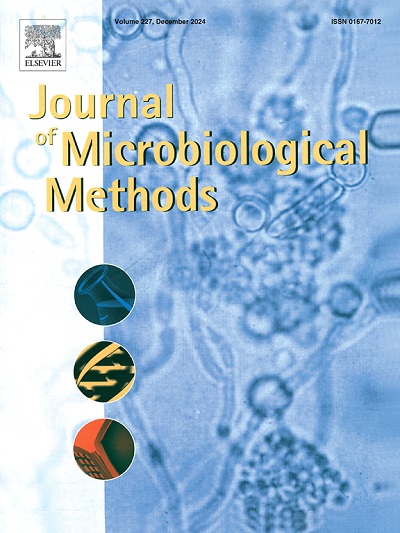Comparison of molecular serotyping methods for Actinobacillus pleuropneumoniae and analysis of atypical serotypes detected in routine diagnostics
IF 1.9
4区 生物学
Q4 BIOCHEMICAL RESEARCH METHODS
引用次数: 0
Abstract
Clinical outbreaks due to Actinobacillus pleuropneumoniae (APP) and subclinical infections have high impact on swine health status worldwide although several commercial vaccines are available. Autogenous vaccination programs are implemented when APP outbreaks occur in commercially vaccinated herds. The identification and characterization of the involved APP serotypes is therefore crucial for the implementation of preventive strategies and antimicrobial usage reduction on the farm. Interpretation of serotyping results obtained by different methods might be difficult in case of mismatching results or untypable APP isolates. In this study results of two routine serotyping methods- a capsular gene based and an apx toxin gene PCR- were compared in 151 APP field and 19 APP reference strains. APP species was identified after bacterial culture by MALDI-TOF-MS followed by serotyping. Toxin profiles were not in accordance with the serotype defined by capsule gene PCR in 37 % of APP field strains which were grouped in those with (1) atypical capsule (cps) gene patterns (22 %) and those with (2) atypical apxIV toxin gene length (78 %). Selected atypical APP strains were further analysed by whole genome sequencing. The toxin gene-based PCR robustly identified the apxI-III toxin genes in all strains and revealed highly variable apxIV toxin gene patterns. For thirteen isolates a cps-gene type 6 and apxIV toxin gene pattern of serotype 2/8/15 could be confirmed via WGS. For three serotype 9/11 isolates the failure of the cps gene typing was found to be due to a deletion at the 3′ of the cpsF gene. A standardized, precise description of the apx-toxin gene pattern as well as the cps-gene-based serotype for APP strains can be recommended (e.g. APP cps type 2, apx gene profile apxIB, apxII, apxIII).
胸膜肺炎放线杆菌分子血清分型方法的比较以及对常规诊断中检测到的非典型血清型的分析
尽管有几种商业疫苗可用,但由胸膜肺炎放线菌(APP)和亚临床感染引起的临床暴发对世界范围内的猪健康状况有很大影响。在商业接种过疫苗的畜群中发生APP疫情时,实施自体疫苗接种计划。因此,所涉及的APP血清型的识别和表征对于在农场实施预防策略和减少抗菌素使用至关重要。在结果不匹配或无法分型的APP分离株的情况下,不同方法获得的血清分型结果可能难以解释。本研究比较了荚膜基因和荚膜毒素基因PCR两种常规血清分型方法在151株APP田间和19株APP参比菌株中的分型结果。细菌培养后采用MALDI-TOF-MS进行菌种鉴定,并进行血清分型。37%的APP田间菌株毒素谱与荚膜基因PCR确定的血清型不一致,分为(1)非典型荚膜(cps)基因型(22%)和(2)非典型apxIV毒素基因长度型(78%)。对所选非典型APP菌株进行全基因组测序分析。基于毒素基因的PCR检测结果显示,所有菌株的apxI-III毒素基因均具有高度变异的apxIV毒素基因图谱。13株分离株经WGS鉴定为cps- 6基因型和apxIV毒素基因型为2/8/15血清型。对于3株9/11血清型分离株,发现cps基因分型失败是由于cpsF基因3 '的缺失。可以推荐对APP菌株的apx毒素基因模式以及基于cps基因的血清型进行标准化、精确的描述(例如APP cps 2型,apx基因谱apxIB、apxII、apxIII)。
本文章由计算机程序翻译,如有差异,请以英文原文为准。
求助全文
约1分钟内获得全文
求助全文
来源期刊

Journal of microbiological methods
生物-生化研究方法
CiteScore
4.30
自引率
4.50%
发文量
151
审稿时长
29 days
期刊介绍:
The Journal of Microbiological Methods publishes scholarly and original articles, notes and review articles. These articles must include novel and/or state-of-the-art methods, or significant improvements to existing methods. Novel and innovative applications of current methods that are validated and useful will also be published. JMM strives for scholarship, innovation and excellence. This demands scientific rigour, the best available methods and technologies, correctly replicated experiments/tests, the inclusion of proper controls, calibrations, and the correct statistical analysis. The presentation of the data must support the interpretation of the method/approach.
All aspects of microbiology are covered, except virology. These include agricultural microbiology, applied and environmental microbiology, bioassays, bioinformatics, biotechnology, biochemical microbiology, clinical microbiology, diagnostics, food monitoring and quality control microbiology, microbial genetics and genomics, geomicrobiology, microbiome methods regardless of habitat, high through-put sequencing methods and analysis, microbial pathogenesis and host responses, metabolomics, metagenomics, metaproteomics, microbial ecology and diversity, microbial physiology, microbial ultra-structure, microscopic and imaging methods, molecular microbiology, mycology, novel mathematical microbiology and modelling, parasitology, plant-microbe interactions, protein markers/profiles, proteomics, pyrosequencing, public health microbiology, radioisotopes applied to microbiology, robotics applied to microbiological methods,rumen microbiology, microbiological methods for space missions and extreme environments, sampling methods and samplers, soil and sediment microbiology, transcriptomics, veterinary microbiology, sero-diagnostics and typing/identification.
 求助内容:
求助内容: 应助结果提醒方式:
应助结果提醒方式:


